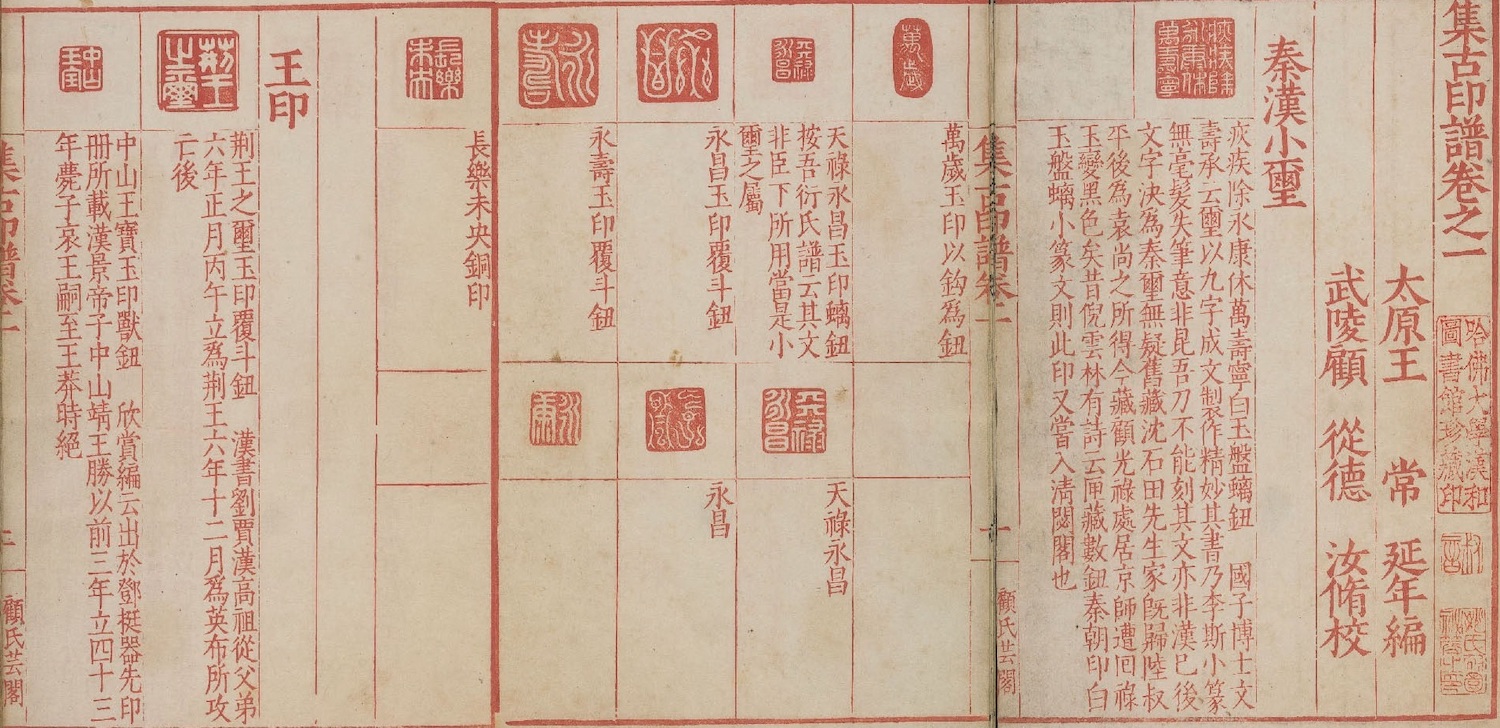Ji guyin pu 集古印譜 "Collection of ancient seals", also called Yinsou 印藪 "Grove of seals" is a catalogue of ancient seals owned by the brothers Gu Congde 顧從德 (1519-1587), courtesy name Ruxiu 汝修, style Yunge 蕓閣, and Gu Congli 顧從禮, style Ruyou 汝由. They inspected closely the antique collection of their father, Gu Dingfang 顧定芳, courtesy name Shi'an 世安, who was an imperial physician. A third brother, Gu Congyi 顧從義, courtesy name Ruhe 汝和 – a famous calligrapher – and a relative called Gu Tianxi 顧天錫 (1588—1663), courtesy name Chongguang 重光, an astronomer and physician, were also consulted with.
The book itself was produced by the seal carver and specialist Wang Chang 王常 (b. 1535), original name Luo Wangchang 羅王常 or Luo Nandou 羅南斗, style Yannian 延年. The preface says that Wang was the compiler of the catalogue, while Gu produced annotations. The book itself is also known by the title Gushi ji guyin pu 顧氏集古印譜 to distinguish it from other books on ancient seals. The name Yinsou was given by the painter Wang Zhideng 王稚登 (1535-1614). It has a length of 6 juan and was finished in 1572 and presents the shape and inscriptions of no less than 1,600 bronze seals (tongyin 銅印) and 160 jade seals (yuyin 玉印) from the Qin 秦 (221-206 BCE) and Han 漢 (206 BCE-220 CE) periods, both private and official ones. It was the first book which showed the original prints of ancient seals.
A second, slightly enlarged version from 1575 has the title Yinsou. Gu Congde commissioned the production of this version to Wang Chang 王常, but Gu made the commentaries on each seal. The result presents 1,340 reproductions of seals, printed in red insight of a red grid pattern, with between four and six seals per page. Apart from the original preface, the Yinsou version also includes a foreword written by Wang Zhideng 王穉登 (1535-1612), who is also said to have chosen the title Yinsou. The two names for Gu Congde's book are often thrown together and make it difficult to discern the original version from the enlarged one.
Earlier books on seals from the Song period 宋 (960-1279) are lost. There were Yang Keyi's 楊克一 (c. 1100) Ji guyin ge 集古印格 (Yangshi ji guyin pu 楊氏集古印譜), Zhao Jie's 趙佶 (i.e. Emperor Huizong 宋徽宗, r. 1100-1126) Xuanhe yinpu 宣和印譜, and Jiang Kui's 姜夔 (1155-1221) Ji guyin pu 集古印譜.
The book of the Gu collection, printed on high-quality white-yellowish silk (chusu 楮素) and wrapped in preciously decorated jackets, can be seen as the crown of seal catalogues. It was published in 20 copies, but the text circulated in five different editions with different numbers of fascicles. These editions partially deviate substantially from the Gu collection, and can be seen as merely inspired by this forerunner of seal catalogues.
These are Gan Yang's 甘晹 version (see Ji guyin zheng 集古印正) from 1596 with 5 juan length (also known as Ji guyin zheng 集古印正), Gu Ruxiu's separate version from 1611 with 7 juan of length, Qu Yong's 瞿鏞 (1794-1846) version published in 1858, and Mo Shengsun's 莫繩孫 (1844-1919) brief version from 1909. While the versions of Gan, Qu, and Mo are printed in black and sealed afterwards (qianyin ben 鈐印本), the main text of the versions of Wang and the Gu brothers is fully printed in red (zhuyin ben 朱印本).
 |
The commentaries do not only transcribe the characters of the seal inscriptions, but also describes the appearance of the seal (fu 覆 "the cover") itself, like a trapezoid square (douniu 斗鈕) or the shape of a (mythological) animal (shouniu 獸鈕). Source: Guangming zhi Men 光明之門. |
The book Fanshi ji guyin pu 范氏集古印譜 was compiled by Fan Rutong 范汝桐, courtesy name Fengzhou 鳳洲, who catalogued the seal collection of his father Fan Dache 范大轍 (1524-1610), courtesy name Zixuan 子宣, style Ne'an 訥庵, Nanyan Diaozhe 南海釣者 or Juzhang Guanyuan Sou 句章灌園叟. It was published in 1597 in 10 volumes and presents more than 3,000 seals. Along with Gu Congde's Gushi ji guyin pu, and Guo Changzong's 郭昌宗 Songtange yinshi 松談閣印史, it belongs to the three significant Ming-period collections of ancient seals.
The catalogue Yangshi ji guyin pu 楊氏集古印譜 had been compiled during the Yuan period 元 (1279-1368) by Yang Zun 楊遵 (fl. 1338), courtesy name Zongdao 宗道, from Pucheng 浦城. It is lost, barring the prefaces by Wang Yi 王沂 (d. 1362), Yu Xilu 俞希鲁, Tang Yushi 唐愚士 (1350-1401), Zhou Boqi 周伯琦 (1298-1369) and Wang Yi 王禕 (1322—1373) that are quoted in Gu Congde's catalogue.
There are also Feng Yilin's 馮一麐 Fengshi ji guyin pu 馮氏集古印譜 from 1714, and Xu Lian's 許槤 (1787-1862)Xushi ji guyin pu 許氏集古印譜 from 1829.